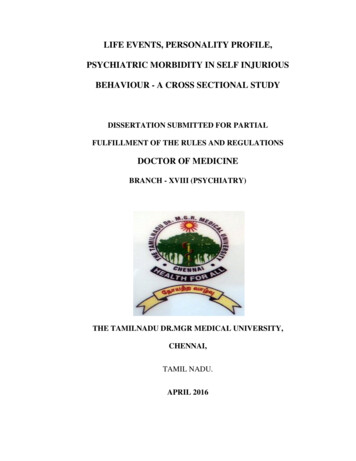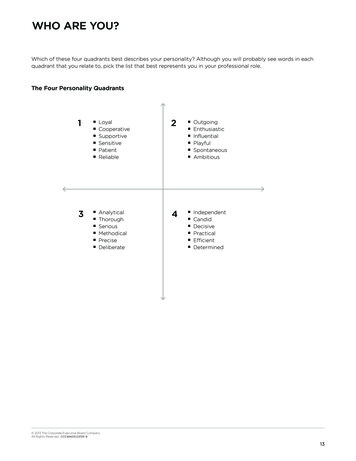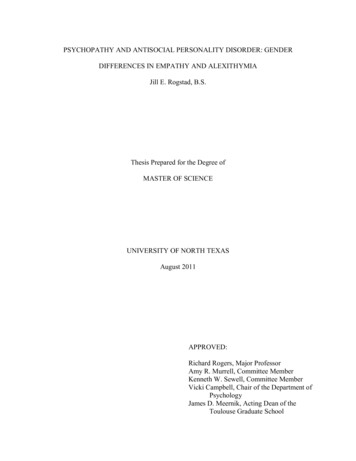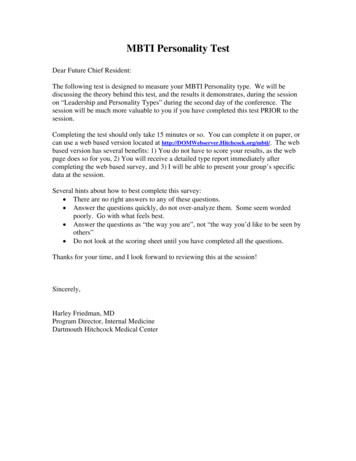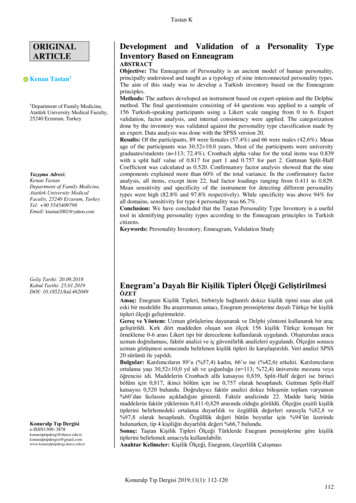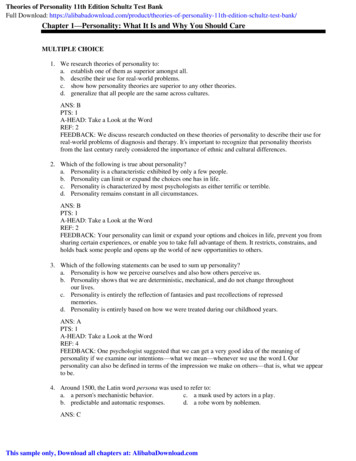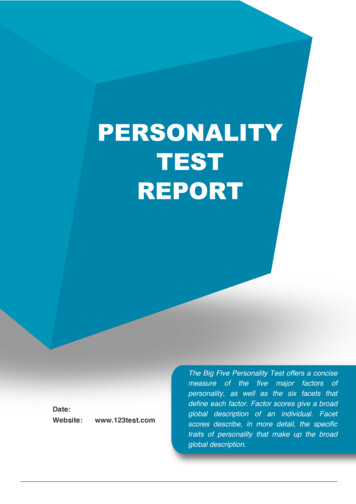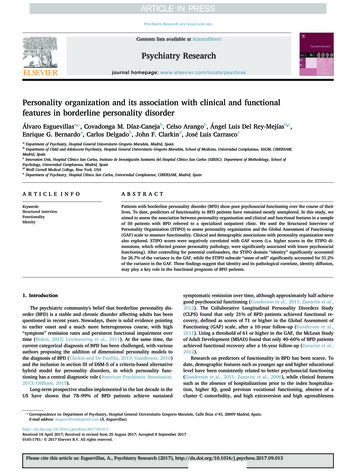
Transcription
Psychiatry Research xxx (xxxx) xxx–xxxContents lists available at ScienceDirectPsychiatry Researchjournal homepage: www.elsevier.com/locate/psychresPersonality organization and its association with clinical and functionalfeatures in borderline personality disorder⁎Álvaro Esguevillasa, , Covadonga M. Díaz-Canejab, Celso Arangob, Ángel Luis Del Rey-Mejíasb,c,Enrique G. Bernardoa, Carlos Delgadob, John F. Clarkind, José Luis CarrascoeaDepartment of Psychiatry, Hospital General Universitario Gregorio Marañón, Madrid, SpainDepartment of Child and Adolescent Psychiatry, Hospital General Universitario Gregorio Marañón, School of Medicine, Universidad Complutense, IiSGM, CIBERSAM,Madrid, SpaincInnovation Unit, Hospital Clínico San Carlos, Instituto de Investigación Sanitaria del Hospital Clínico San Carlos (IdISSC). Department of Methodology, School ofPsychology, Universidad Complutense, Madrid, SpaindWeill Cornell Medical College, New York, USAeDepartment of Psychiatry, Hospital Clínico San Carlos, Universidad Complutense, CIBERSAM, Madrid, SpainbA R T I C L E I N F OA B S T R A C TKeywords:Structured interviewFunctionalityIdentityPatients with borderline personality disorder (BPD) show poor psychosocial functioning over the course of theirlives. To date, predictors of functionality in BPD patients have remained mostly unexplored. In this study, weaimed to assess the association between personality organization and clinical and functional features in a sampleof 50 patients with BPD referred to a specialized outpatient clinic. We used the Structured Interview ofPersonality Organization (STIPO) to assess personality organization and the Global Assessment of Functioning(GAF) scale to measure functionality. Clinical and demographic associations with personality organization werealso explored. STIPO scores were negatively correlated with GAF scores (i.e. higher scores in the STIPO dimensions, which reflected greater personality pathology, were significantly associated with lower psychosocialfunctioning). After controlling for potential confounders, the STIPO domain “identity” significantly accountedfor 26.7% of the variance in the GAF, while the STIPO subscale “sense of self” significantly accounted for 31.2%of the variance in the GAF. These findings suggest that identity and its pathological correlate, identity diffusion,may play a key role in the functional prognosis of BPD patients.1. Introductionsymptomatic remission over time, although approximately half achievegood psychosocial functioning (Gunderson et al., 2011; Zanarini et al.,2012). The Collaborative Longitudinal Personality Disorders Study(CLPS) found that only 21% of BPD patients achieved functional recovery, defined as scores of 71 or higher in the Global Assessment ofFunctioning (GAF) scale, after a 10-year follow-up (Gunderson et al.,2011). Using a threshold of 61 or higher in the GAF, the McLean Studyof Adult Development (MSAD) found that only 40–60% of BPD patientsachieved functional recovery after a 16-year follow-up (Zanarini et al.,2012).Research on predictors of functionality in BPD has been scarce. Todate, demographic features such as younger age and higher educationallevel have been consistently related to better psychosocial functioning(Gunderson et al., 2011; Zanarini et al., 2006), while clinical featuressuch as the absence of hospitalizations prior to the index hospitalization, higher IQ, good previous vocational functioning, absence of acluster C comorbidity, and high extraversion and high agreeablenessThe psychiatric community's belief that borderline personality disorder (BPD) is a stable and chronic disorder affecting adults has beenquestioned in recent years. Nowadays, there is solid evidence pointingto earlier onset and a much more heterogeneous course, with high“symptom” remission rates and persistent functional impairment overtime (Biskin, 2015; Leichsenring et al., 2011). At the same time, thecurrent categorical diagnosis of BPD has been challenged, with variousauthors proposing the addition of dimensional personality models tothe diagnosis of BPD (Clarkin and De Panfilis, 2013; Gunderson, 2010)and the inclusion in section III of DSM-5 of a criteria-based alternativehybrid model for personality disorders, in which personality functioning has a central diagnostic role (American Psychiatric Association,2013; Oldham, 2015).Long-term prospective studies implemented in the last decade in theUS have shown that 78–99% of BPD patients achieve sustained⁎Correspondence to: Department of Psychiatry, Hospital General Universitario Gregorio Marañón, Calle Ibiza n 43, 28009 Madrid, Spain.E-mail address: aesguevillas0@gmail.com (Á. 2017.09.013Received 18 April 2017; Received in revised form 25 August 2017; Accepted 8 September 20170165-1781/ 2017 Elsevier B.V. All rights reserved.Please cite this article as: Esguevillas, A., Psychiatry Research (2017), http://dx.doi.org/10.1016/j.psychres.2017.09.013
Á. Esguevillas et al.traits have been identified as predictors to recovery (Zanarini et al.,2014). However, the relationship between the functional outcome ofBPD and the core etiological features of the disorder according to thethree major evidence-based treatment models (Gunderson,2016)—emotion dysregulation, mentalizing deficits, and syndrome ofidentity diffusion—has been mostly unexplored. From the perspectiveof biosocial theory, higher levels of emotional dysregulation have beenrelated to poorer psychosocial functioning (Wilks et al., 2016), whilefrom the perspective of structural personality organization, lower levelsof personality organization have been associated with greater clinicalseverity of the disorder (Hörz et al., 2010).The structural personality organization construct is essentially adimensional model of personality that proposes four broad types ofpersonality organization (normal, neurotic, borderline, and psychotic)(Kernberg, 1967). In this model, borderline personality organization(BPO) is defined by the syndrome of identity diffusion, the pervasiveuse of primitive defensive mechanisms, and intact reality testing withexceptional alterations related to stressful situations, as well as severalmanifestations of ego weakness. From a clinical point of view, BPOincludes some of the most severe personality disorders, including BPD(Kernberg, 1984). The domains of functioning central to the personalityorganization model can be assessed using a semi-structured interview,the Structured Interview of Personality Organization (STIPO) (Clarkinet al., 2003).In this study, we provide a novel approach to the study of structuralpersonality organization by using a dimensional measure such as thatprovided by the STIPO and focusing specifically on its association withfunctionality and specific clinical features in BPD. We hypothesizedthat, among the dimensions assessed with the STIPO, the syndrome ofidentity diffusion and the predominant use of primitive defenses (i.e.the core features of Kernberg's model) would be significantly associatedwith poor functionality.2. Methods2.1. Participants and data collectionFifty patients with a presumptive diagnosis of BPD were referredbetween January and June 2015 to a specialized outpatient unit forevaluation by a consultant psychiatrist specialized in BPD (JLC). Theinclusion criteria were age 18 years, and a confirmed diagnosis ofBPD according to DSM-IV criteria after the initial clinical assessment.The exclusion criteria were having a lifetime diagnosis of psychotic,bipolar or organic brain disorder, or being diagnosed in the initialclinical evaluation of a current major depressive episode or mentalretardation. 43 patients (86%) fulfilled the clinical diagnostic criteriafor BPD after the initial evaluation and were included in the study. Ofthe seven patients who did not fulfill diagnostic criteria for BPD afterthe initial clinical evaluation and were excluded from the study, fivehad a lifetime diagnosis of a psychotic disorder, one had a lifetime diagnosis of a bipolar disorder, and one had a lifetime diagnosis of a nonspecified eating disorder.JLC administered the clinical and demographic questionnaires, theGAF, the CTQ, the CGI-BPD and the SCID II to the 43 patients finallyincluded in the study, while an independent consultant psychiatrist(AE) administered the STIPO. Every scale was administered by a singleinterviewer, and both interviewers were blind to the results of the assessments they did not conduct. The study was approved by the localethics committee, and written consent was obtained from all the participants after they received a complete explanation of the study.2.2. Materials2.2.1. Assessment of personality organizationWe used a Spanish translation of STIPO 1.07, which is a newer andshorter version of the original 100-item STIPO, used mainly in researchPsychiatry Research xxx (xxxx) xxx–xxxstudies (Clarkin et al., 2007). STIPO 1.07 has 87 individual items divided into six main domains and eight secondary subscales. Each item israted from zero (no pathology) to two (clear pathology). The domainsand subscales of the interview are “identity” (with three subscales:“capacity to invest”, “sense of self – coherence and continuity”, and“sense of others”); “object relations” (with three subscales: “interpersonal relationships”, “intimate relations and sexuality”, and “internal working model of relationships”); “primitive defenses”; “adaptive coping vs. rigidity”; “aggression” (with two subscales: “selfdirected aggression” and “other-directed aggression”); and “moral values”. Domain and subscale scores were calculated according to fivepoint rating scales, which are rated from one (no pathology) to five(severe pathology) based on scores in the individual STIPO items, theexaminee's non-verbal behavior during the interview, and the interviewer's clinical sense of the examinee. The STIPO has shown goodpsychometric properties both in its English (intraclass correlations 0.96for identity, 0.97 for primitive defenses; Cronbach's alpha 0.86 foridentity, 0.85 for primitive defenses) (Stern et al., 2010), and Germanversions (intraclass correlations between 0.89 and 1.0 for the STIPOdimensions; Cronbach s alpha between 0.80 and 0.93 for the STIPOdimensions) (Doering et al., 2013). Competent administration requiresfamiliarity with the constructs underlying assessment of personalityorganization, formal training as a clinical interviewer, and experienceadministering semi-structured interviews (Clarkin et al., 2007). Thepsychiatrist who administered the STIPO (AE) received training duringa fellowship at the Personality Disorders Institute, consisting in theoretical lessons, and assessment followed by supervision of STIPO videorecorded interviews with trained interviewers. One of the original authors of the interview, John Clarkin, gave his permission for the application of the STIPO in this study.2.2.2. Assessment of psychosocial functioningWe used the DSM-IV Axis V Global Assessment of Functioning GAF- score (American Psychiatric Association, 1994) as the measure offunctioning in our sample. The GAF scale is based on a continuumbetween mental health and mental disease and is divided into 100points, with “100″ representing the maximum level of functioning and“1″ the minimum level of functioning. We used the GAF scale both as adichotomous and as a continuous variable. When used as a dichotomous variable, good psychosocial functioning was defined as a GAFscore of 61 or higher, because this score offers a reasonable descriptionof a good overall outcome, including at least one significant interpersonal relationship and an acceptable vocational record (i.e. somemild symptoms or some difficulty in social, occupational or schoolfunctioning, but generally functioning quite well; has some meaningfulinterpersonal relationships). This GAF cut-off point of “61” has beenused in previous research studies on functionality in BPD (Zanariniet al., 2012).2.2.3. Clinical assessmentWe created a specific clinical questionnaire to assess clinical features - history of non-suicidal self-injury, history of suicide attempts(SA), comorbidity with substance use disorders (SUD - alcohol, cannabis, and stimulants), and attention-deficit hyperactivity disorder(ADHD) - found to be relevant in BPD (Oldham, 2006; Philipsen et al.,2008; Tomko et al., 2014; Zanarini et al., 2011, 2013). We assessedthese variables as dichotomous variables (yes/no). Both trauma historyand sexual abuse history were assessed based on the Spanish version ofthe Childhood Trauma Questionnaire (CTQ), which has previouslyshown good internal consistency reliability (Hernandez et al., 2013) Weused the Spanish version of the Clinical Global Impression-BorderlinePersonality Disorder (CGI-BPD) scale as a measure of clinical severity(Cronbach s alpha 0.85, intraclass correlations from 0.78 for rage to0.93 for paranoid ideation) (Perez et al., 2007), and the Spanish versionof the Structured Clinical Interview for DSM IV Axis II Disorders (SCIDII) (First et al., 1999) as a measure of comorbidity with other cluster B
Psychiatry Research xxx (xxxx) xxx–xxxÁ. Esguevillas et al.personality disorders. The SCID-II has shown good reliability and validity (First et al., 1995; Skodol et al., 1988) and has been previouslyvalidated in Spanish (Gómez Beneyto et al., 1994)Table 1Clinical and demographic characteristics of the sample (N 43).Age, yearsaSex, femalebMarital status, singlebEducational statusb:Elementary schoolHigh schoolCollegeEmployment ed disabilitybAge at first consultation, yearsaYears of treatmentaCurrent treatmentb:UntreatedOutpatient unitPartial hospitalizationInpatient unitPharmacological treatment, any kindbHistory of suicide attemptsbSuicide attemptsaHistory of non-suicidal self-injuriesbHistory of traumaaSexual abusecADHD diagnosisbCannabis usebStimulant usebSubstance dependence, any kindbComorbid cluster A personality disorder, SCID IIdbParanoid personality disorder SCID-IISchizoid personality disorder SCID-IISchizotypal personality disorder SCID-IIComorbid cluster B personality disorder, SCID IIdbHistrionic personality disorder SCID-IIAntisocial personality disorder SCID-IINarcissistic personality disorder SCID-IIComorbid cluster C personality disorder, SCID IIdbDependent personality disorder SCID-IIAvoidant personality disorder SCID-IIObsessive-compulsive personality disorder SCID-IICGI BPDaCGI BPD 5bCGI BPD 5bGAFaGAF 61bGAF 61b2.3. Statistical analysisNormality of all variables was tested using the Kolmogorov-Smirnovtest. Non-parametric tests were used for variables not showing a normaldistribution. To analyze the association between the STIPO scores anddichotomous clinical and functional measures (using a cut-off point forthe GAF of 61), data were analyzed using the Mann-Whitney test. Thecorrelation between the scores in the STIPO and the GAF scale as acontinuous variable was assessed using the Spearman rank correlationcoefficient. Finally, we designed two predictive multiple linear regression models using a stepwise backward elimination method to assessthe effect of personality organization on functionality, with the GAF asthe dependent variable and the STIPO domains or subscales as independent measures, controlling for potential confounders (sex, age,trauma, suicide attempts, comorbidity with cluster B personality disorder, ADHD, and SUD). The linear regression model assumptions(homoscedasticity, linear relationship, multivariate normality, lack ofauto-correlation and multicollinearity) were tested for both models.The significance threshold was set at P 0.05, and a Bonferronicorrection for multiple comparisons was applied when needed. Theseanalyses were performed using SPSS (v.18.0). Effect sizes (ES) werereported with η2 for parametric and non-parametric tests (Rosenthaland DiMatteo, 2001).3. ResultsThe demographic and clinical characteristics of the sample arepresented in Table 1. STIPO scores on the five-point rating scales for thesix domains and eight subscales of the interview are presented in Fig. 1.Higher scores in the STIPO domains reflecting the core features ofKernberg's personality organization model (identity and use of primitive defenses) were found in patients with comorbid antisocial personality disorder (identity, U 52.5, p 0.002; η2 0.23; use ofprimitive defenses, U 39, p 0.001; η2 0.31) and with greaterclinical severity (CGI-BPD scores 5 reflecting a clinical severity of“markedly ill” or greater) (U 94.5, p 0.008, η2 0.17 for identity;and U 95, p 0.008, η2 0.16 for use of primitive defenses).Higher scores in the domain identity were also associated with a historyof childhood sexual abuse (U 77.5, p 0.016, η2 0.16).Associations between STIPO domains and subscales and clinical features are shown in Table 2.Using scores in the GAF as a dichotomous variable, significant differences were found in the STIPO scores between the groups with goodfunctionality (GAF 61) and poor functionality (GAF 61) in alldomains except for “aggression” and “moral values” and in all subscalesexcept for “internal working model of relationships” and “self-directedaggression”, with the largest ES found in the following subscales ofidentity: “capacity to invest” (U 64.5, p 0.001, η2 0.24); “senseof self” (U 60.5, p 0.001, η2 0.28), and “sense of others” (U 78.5, p 0.003, η2 0.20) (see Fig. 2). Using the GAF scale as acontinuous variable, GAF scores were significantly correlated with thescores in all domains of the STIPO except for “aggression” and in allsubscales of the STIPO except for “self-directed aggression”. The largestES were found for the correlations between the GAF scores and thescores in the domain “identity” (r –0.552, p 0.001, η2 0.30) andin the subscales “capacity to invest” (r –0.577, p 0.001, η2 0.33) and “sense of self” (r –0.581, p 0.001, η2 0.34).In the linear regression predictive models, the STIPO domain“identity” (B –6.3; 95% CI –9.4 to –3.1; p 0.001; η2 0.267) wasthe only statistically significant predictor of GAF scores (functionality);among the STIPO subscales, “sense of self” was the only statisticallysignificant predictor of functionality (B –6.4; 95% CI –9.3 to –3.5;abcd31.74 (9.2); [18 to 50]35 (81)39 (91)2 (5)24 (56)17 (40)9 (20)16 (37)13 (30)5 (12)8 (19)19.44 (7.5); [7 to 43]12.30 (8.1); [0 to 34]3 (7)23 (53)15 (35)2 (5)38 (88)28 (65)2.56 (5.1); [0 to 32]32 (74)26 (60)13 (30)3 (7)19 (44)11 (26)6 (14)21 (51)19 (46)10 (24)7 (17)17 (41)6 (15)9 (22)9 (22)27 (66)15 (37)20 (49)15 (37)3.63 (1.3); [2 to 6]12 (28)31 (72)70.23 (10.7); [50 to 90]11 (26)32 (74)Quantitative variables are presented as mean (SD); [range].Qualitative variables are presented as N (%).All cases of sexual abuse were in female patients.SCID II scores were only assessed in 41 patients.123456Iden tyCapacity to investSense of self – coherence and con nuitySense of othersObject rela onsInterpersonal rela onshipsIn mate rela onships and sexualityInternal working model of rela onshipsPrimi ve defensesAdap ve coping vs. RigidityAggressionSelf-directed aggressionOther directed aggressionMoral values1Fig. 1. STIPO domains and subscales2 5-point rating scales (shown as median values and interquartile ranges). 1STIPO domains median values are shown in red,2STIPO subscales median values are shown in pink.3
Psychiatry Research xxx (xxxx) xxx–xxxÁ. Esguevillas et al.Table 2Association between STIPO domains and identity domain subscales based on clinical features of the sample (N 43) (Effect sizes shown as η2).STIPOIdentityCapacity toinvestSense of selfSense ofothersObjectrelationsPrimitivedefensesAdaptive coping vs.rigidityAggressionMoralvaluesSex (female)Sexual abuse (N 35)aNSSISACluster A PD (N 41)bCluster B PD (N 41)bCluster C BPD (N 41)bAPD (N 41)bSDDCGI 050.06 0.0010.2**0.0040.050.030.020.02 0.0010.070.002 0.0010.06 0.001 0.0010.060.02 0.0010.010.050.020.030.040.0070.050.003 .11*0.040.16**0.060.050.070.050.06 0.230.020.17****0.230.0060.18**0.050.020.19***0.15 0.14*0.13 0.0010.05SA suicide attempts.NSSI non-suicidal self-injuries.PD personality disorder.APD antisocial personality disorder.SDD substance dependence disorder (alcohol, cannabis, or stimulants [including cocaine]).CGI 5 clinical global impression score of “markedly ill”, “severely ill”, or “among the most extremely ill patients”.* p 0.05.** p 0.01.†p 0.05 after Bonferroni correction.aAll cases of sexual abuse were in female patients. The analysis was made with the female subsample.bSCID II data for other cluster A, cluster B and cluster C PD comorbidities were only available for 41 patients.p 0.001; η2 0.312).Considering the significant association found between history of childhood sexual abuse and the STIPO domain “identity”, we made a sensitivityanalysis restricted to the sample of patients without history of childhoodsexual abuse. In this analysis, we obtained similar results for the linear regression predictive model assessing the effect of the STIPO domains, being“identity” (B 6.6; 95% CI 10.1 to 3.0; p 0.001; η2 0.310) theonly statistically significant predictor of GAF scores. In the linear regressionpredictive model including the STIPO subscales as independent measures,we found that the subscales “sense of self” (B 4.4; 95% CI 8.2 to 0.6; p 0.027; η2 0.092) and “interpersonal relationships” (B 3.7; 95% CI 6.8 to 0.6; p 0.024; η2 0.330) were statisticallysignificant predictors of functionality.U 79**5U 99*η2 0.134.5U 84.5**η2 0.174. DiscussionTo our knowledge, this is the first study to specifically assess whichdomains of the structural personality organization model might be associated with functionality in BPD patients. The importance of thefunctional assessment of BPD patients has been highlighted by severalauthors. Functional impairment of BPD patients, which is similar to thatof patients with other serious mental illnesses, often goes unnoticed bypatients themselves and their therapists, thus generating misleadingoptimism in the assessment of their adaptive capacities (Gunderson andLinks, 2008). In our study, the “identity” domain and the “sense of self”subscale were the only significant predictors of functionality betweenthe STIPO domains and subscales, after controlling for potentialFig. 2. Differences in STIPO domains between patients withgood (GAF 61) and poor (GAF 61) psychosocial functioning1 (N 43) (Effect sizes shown as η2). 1STIPO scores aregraphically expressed with the statistical value “mean”.*p 0.05; **p 0.01, U Mann-Whitney U test.U 87**η2 0.16U 115.543.5U 111.5GAF 61(N 32)GAF 61(N 11)32.521.51IdentityObject relationsPrimitive defensesAdaptive copingAggressionMoral values4
Psychiatry Research xxx (xxxx) xxx–xxxÁ. Esguevillas et al.personality organization model (identity diffusion and use of primitivedefenses) were significantly associated with clinical features of considerable importance in BPD, such as the presence of childhood sexualabuse or comorbidity with any other cluster B personality disorder,especially antisocial personality disorder. The presence of significanttrauma during the psychological growth of the child has been found tobe a key etiological factor for the subsequent development of BPO(Kernberg, 1975). The relationship between trauma and both a lowerlevel of personality organization (Yalch and Levendosky, 2014) andhigher levels of clinical severity and functional impairment in BPD wasrecently studied (Frías and Palma, 2015). Comorbidity with any othercluster B personality disorder has been related to higher clinical severity (Barrachina et al., 2011) and a lower level of personality organization (Hörz et al., 2010). The association between higher scores inthe STIPO domains “identity” and “primitive defenses” and the presence of a comorbid antisocial personality disorder is concordant bothwith the personality organization model, in which antisocial personality disorder is placed at the lowest level of BPO (Kernberg, 1984) andwith the view of other authors who favor a phenomenological approachand who consider antisocial personality disorder to be related to amarked functional disability in adulthood (Black, 2015; Paris et al.,2013).The distribution of STIPO scores in the sample, with mean domainvalues between three and four, matched the BPO prototype suggested ina previous study (Hörz et al., 2009) and was similar to the distributionof the STIPO domain scores shown in other studies in which the STIPOwas administered to German and Austrian patients (Doering et al.,2013; Fischer-Kern, 2010).Finally, STIPO scores on the main domains of the structural personality organization model (identity diffusion and predominant use ofprimitive defenses) were not significantly associated with suicidal attempts, non-suicidal self-injuries, ADHD, or SUD. Although a worselevel of personality organization has been associated to suicidal attempts in previous studies (Hörz et al., 2010), our results are in linewith other findings of a lack of association of the main domains of thestructural personality organization model with suicidality, when explored independently (Baus et al., 2014). Overall, these clinical featuresare included in the psychopathological factor “behavioral dyscontrol”,which is related to the psychobiological domain “impulsive aggression”(Gunderson, 2010; Siever and Davis, 1991). This finding is concordantwith those of a recent study on familial aggregation of candidate phenotypes for BPD, in which aggressiveness was only weakly related toBPD, suggesting that this phenotype may not represent an essentialfeature of BPD (Ruocco et al., 2015).Our study is subject to a series of limitations. First, we did not include a control/comparison group, which made us unable to statewhether similar associations between personality organization andpsychosocial functioning would have been found in patients with noBPD. Further studies including a control/comparison group could helpdraw more definitive conclusions about this association. Second, theSTIPO has not yet been validated in a Spanish population, thus limitingthe scope of the results obtained. We took this limitation into accountbefore starting the study. However, considering the characteristics ofthe STIPO as a semi-structured interview and our application of thestudy as a preliminary, exploratory assessment of the personality organization model in a Spanish BPD sample, we believe that this limitation did not represent an insurmountable barrier for performance.That said, the development of a validated Spanish version of the STIPOwould enable a more detailed study of the relationship between identitypathology and functional disability in Spanish BPD patients.Additionally, it should be considered that there is a degree of subjectivity in the STIPO assessment that we tried to minimize using asingle trained interviewer (AE), although we did not have any externalsupervision or gold standard comparison, which would have helped toreduce the degree of subjectivity of the interview. Third, the use of theGAF scale as a measure of functionality results in a number ofconfounders. Specifically, we found that for each point that the STIPO“identity” domain score increased, the GAF score decreased 6.284points; while for each point that the STIPO “sense of self” subscale scoreincreased, the GAF score decreased 6.451 points. Although we can assume that there is some overlap between the STIPO domain identityand the GAF scale (in particular between the “capacity to invest” subscale and the GAF score, which focus on school and work functioning),we believe that both scales assess different constructs, with the identityconstruct in particular including an assessment of the inner world of thepatient alongside its behavioral correlate. In fact, in the STIPO subscales, the “sense of self” subscale, which focuses on the inner experience of the patient, was the only significant predictor of functionality.Our finding of an association between higher scores in the STIPO andlower GAF scores, which indicates that lower levels of personality organization were associated with poorer psychosocial functioning, isconsistent with the findings of a previous study in a German population(Hörz et al., 2010), in which the impact of specific dimensions was notassessed. Taking into account this study as a preliminary, exploratoryassessment of the personality organization model in a Spanish BPDsample, these results suggest that identity diffusion might be useful inthe prediction of functional outcomes in BPD. Identity diffusion is aconcept that was first described by Erikson in his seminal work on egoidentity, in which he referred to the subjective experience of the self,defined as an absence or loss of the normal capacity for self-definitionand reflected in the presence of an emotional breakdown in moments ofphysical intimacy, vocational election, competition, and increased needfor a psychosocial definition (Erikson, 1956). This concept was laterdeveloped by Kernberg as the cornerstone of his personality organization model, adding the subjective experience of the other to Erikson'sconcept of identity, within an object relations theoretical framework(Kernberg, 1967, 2006); and was recently addressed in the first twoitems (identity and self-direction) of the Level of Personality Functioning Scale included in the DSM-5 section III alternative hybrid modelfor personality disorders (American Psychiatric Association, 2013).In the subsample of patients without history of childhood sexualabuse, we found the same results in the regression analyses includingthe STIPO domains as independent measures to those found in thewhole sample, suppo
of personality organization have been associated with greater clinical severity of the disorder (Hörz et al., 2010). The structural personality organization construct is essentially a dimensional model of personality that proposes four broad types of personality organization (normal, neurotic,
